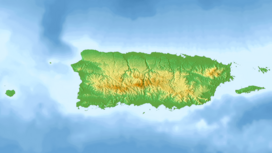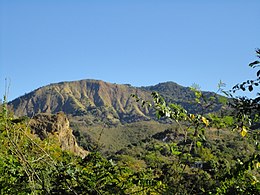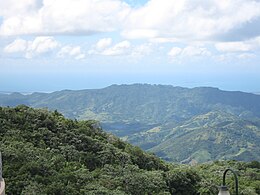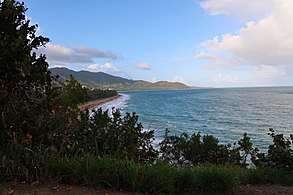Puerto Rico Cordillera Central
The Cordillera Central (English: Central Mountain Range), is the main mountain range in Puerto Rico.
The range crosses the island from west to east and divides it into its northern and southern coastal plains. The Cordillera Central runs eastward from the municipality of Maricao in the west to Aibonito in the central eastern region, and on to the Caribbean in the southeast through the Sierra Cayey.
| Cordillera Central | |
|---|---|
 Cordillera Central runs through the municipality of Corozal, among others in central Puerto Rico. | |
| Highest point | |
| Peak | Cerro de Punta |
| Elevation | 4,390 ft (1,340 m) |
| Coordinates | 18°10′21″N 66°35′31″W / 18.17250°N 66.59194°W |
| Geography | |
Location of the highest point of the Cordillera Central in Puerto Rico. | |
| Location | |
| Region | Caribbean |
The Central Mountain Range consists of the Cordillera Central proper and numerous subranges (such as the Sierra de Cayey), foothills and ridges that extend throughout the island. Cerro de Punta is both the highest peak of the Cordillera Central and the highest point in Puerto Rico. The Sierra de Luquillo, where El Yunque is located, is sometimes included as a subrange or eastward extension of the Cordillera Central.
History
The region of the Cordillera Central has been inhabited since the pre-Hispanic era. During the Spanish colonization of Puerto Rico, the Cordillera Central was likely shared by different Taíno cacicazgos or chiefdoms: Yagüecax, Otoao, Jatibonico, Guaynia and Turabon. Many of the indigenous Taínos fled to the central mountainous region during the Spanish conquest of Borinquen, and the region today hosts a number of related archaeological sites.
Throughout the history of Puerto Rico, this mountain range has been important for the economy of the island. Due to its climate, the range has been ideal for the cultivation of fruit, vegetables and, most famously, coffee. The coffee cultivation and production in the Cordillera Central intensified throughout the 19th century. This helped develop the mountainous region of the island and attracted a high influx of immigrants from coastal cities such as San Juan and Ponce, but also from Europe thanks to the Royal Decree of Graces of 1815 which encouraged non-Spanish Europeans to settle and cultivate the land. Coffee was one of the most lucrative industries of the region at the time, and it was developed particularly by Corsican immigrants.
The first paved road to span the mountain range was the Carretera Central, which was functional by 1886 and completed in 1898, connecting San Juan in the Atlantic coast to Ponce in the Caribbean coast. Many of the workers involved in its construction were confined Chinese workers from Cuba between the years 1865 and 1880. The original road goes through the municipalities of San Juan (formerly the municipality of Río Piedras), Guaynabo, Caguas, Cidra, Cayey, Aibonito, Coamo, Juana Díaz and Ponce. This was the most important engineering project built by the Spanish government in Puerto Rico during the 19th century and it highly influenced the human development of the region. The original route is now listed in the US National Register of Historic Places. This road is also known as the Military Road (Spanish: Carretera Militar) for its strategic importance and it was used both by the Spanish and US Army during the Puerto Rico campaign of the Spanish-American War of 1898.
Geography
The Puerto Rico Central Mountain Range or Cordillera Central is considered the largest of the three geographical and physiographic provinces of the island, along with the Karst regions and the coastal plains. The mountain range begins in the western part of the island in the municipalities of Maricao, Las Marías and Mayagüez close to the Mona Passage in the west coast of Puerto Rico. Another western portion of the range that is sometimes included in the Cordillera Central, called the Santa Marta Hills, is located to the southwest in the municipalities of Sabana Grande, San Germán, Lajas and Cabo Rojo. This subrange forms the division between the Lajas Valley and the Guanajibo or Sabana Grande Valley, and it connects to the main range of the Cordillera Central in the border between Yauco and Sabana Grande. The Cordillera Central proper keeps eastward through the municipalities of Maricao, Lares, Utuado, Yauco, Adjuntas, Guayanilla, Peñuelas, Ponce, Jayuya, Juana Díaz, Villalba, Ciales, Orocovis, Corozal, Barranquitas, Coamo, Comerío and Aibonito; this section contains the highest peaks of the range and Puerto Rico, such as Cerro de Punta which is the highest point in the island. The Aibonito Pass (also known as Asomante Pass) creates a division between the Cordillera Central proper and its eastward subrange, the Sierra de Cayey, which crosses Cayey, Salinas, Guayama, Caguas, San Lorenzo and Patillas. From this point the range splits in two ridges (often called cuchillas in Spanish): the Sierra de Guardarraya between Patillas and Maunabo in the north, and the Sierra Pandura between Maunabo and Yabucoa in the south; these two small ranges end in the southeastern coast of Puerto Rico next to the Caribbean Sea, forming the plains of the Valley of Maunabo between them.

The Sierra de Luquillo is often included as a subrange of the Cordillera Central, however it is separated from it by the Loíza hydrological basin in the Caguas Valley and numerous other geographical features such as the San Lorenzo batholith.
- Relief map with the Cordillera Central.
- Physiographic map of the geographic provinces.
Geology
The northern edge of the Cordillera Central was formed throughout millions of years through the interactions between the North American and Caribbean plate tectonics. The relief was shaped by an accordion-like motion between both plate tectonics through subduction and transform fault line collisions. In addition to the seismic orogeny, the central mountain ranges are also the product of volcanic activity from 120 million years ago in the Early Cretaceous period, and what is the Cordillera Central today used to be the tips of small islands surrounding larger volcanic islands.
Given its volcanic origin, most of the rocks are of Eocene, Paleocene and Cretaceous volcanic and sedimentary composition. There are also deposits of intrusive rock, composed of quartz diorite, diorite and granodiorite, in addition to alluvium in the central and northern regions, and metamorphic serpentine sedimentary and igneous rock in the western portion.
Ecology
The Cordillera Central is home to most of the endemic plant and animal species in Puerto Rico. The majority of the range is home to Puerto Rican moist forests, belonging to both the tropical and subtropical moist broadleaf forest ecoregion of the Caribbean. This habitat style is often known as jungle (Spanish: selva) and it extends to other geographical provinces of the island such as the karst zones and the coastal lowlands.
Flora
The Cordillera Central is home to several types of forests such as the tropical montane forest, which includes the cloud and dwarf forests, and the subtropical moist forest. Trees at middle elevations tend to be the tallest while those closer to the mountain summits tend to be smaller. Some of the most common plant species are the West Indian treefern (Cyathea arborea), the trumpet tree (Cecropia peltata), the nemoca tree (Ocotea moschata), the West Indian sumac (Brunellia comocladifolia), the yucca plum pine (Podocarpus coriaceus), the candlewood or tabonuco tree (Dacryodes excelsa), the bulletwood (Manilkara bidentata), the Puerto Rican magnolia (Magnolia portoricensis), the maga tree (Thespesia grandiflora), and the Sierra palm tree (Prestoea montana). The foothills are home to plants such as the coroso palm tree (Acrocomia media) and the West Indian locust (Hymenaea courbaril). Most of the endangered species are also endemic, and they include species such as the Cordillera maiden fern (Amauropelta inabonensis), only found in Cerro Rosa, Cook's holly (Ilex cookii) which is only found in Cerro de Punta and Mount Jayuya, and the palo de ramon (Banara vanderbiltii) of which only 20 wild individuals remain. The Caribbean pine (Pinus caribaea) and the West Indian (Swietenia mahagoni) and Honduran mahogany trees (S. macrophylla) have been introduced and successfully adapted to the mountain forests.
Fauna
This region is home to a high number of endemic animal species, most of which are birds and amphibians. In addition to the common coqui (Eleutherodactylus coqui), the mountain forests are home to at least 10 other species of coqui (Eleutherodactylus sp.), some of which are endangered. Some reptile species found in the forest are the Puerto Rican ground lizard (Pholidoscelis exsul), the blind worm lizard (Amphisbaena caeca), the endangered Puerto Rican boa (Chilabothrus inornatus) and the Puerto Rican racer (Borikenophis portoricensis). The most common birds are the Puerto Rican woodpecker (Melanerpes portoricensis), the Puerto Rican tody (Todus mexicanus), the Puerto Rican lizard cuckoo (Coccyzus vieilloti), the zenaida dove (Zenaida aurita), the Puerto Rican emerald hummingbird (Riccordia maugeaus) and the red-tailed hawk (Buteo jamaicensis). The Puerto Rican parrot (Amazona vittata) used to be very common in the region but it is now critically endangered; other endangered birds are the Puerto Rican broad-winged hawk, Bicknell's thrush and the Puerto Rican sharp-shinned hawk.
The rivers and streams that originate in the mountains are home to species such as the mountain mullet (Dajaus monticola) and the gata shrimp (Atya lanipes). There is also a number of bat species found throughout the region including the Antillean ghost-faced bat (Mormoops blainvillei), the greater bulldog bat (Noctilio leporinus) and the sooty mustached bat (Pteronotus quadridens). The invasive small Indian mongoose (Urva auropunctata) and black rat (Rattus rattus) are very common and considered a threat to many endangered native species.
Protected areas
The Central Mountain Range or Cordillera Central contains most of the protected state forests of Puerto Rico:
Climate
The Cordillera Central extends from west to east creating a geographic division between the north and the south of the island. The altitude of these mountains blocks the easterly trade winds and creates a rain shadow that cause the southern plains to have a drier and semi-arid weather than the more tropical humid weather found in the northern part of the island. The Cordillera is the rainiest region of Puerto Rico outside the Sierra de Luquillo. The rainiest periods are between the months of May and December, correlating with the wet season (often used interchangeably with hurricane season), with the months between December and March being relatively the driest.
Some of the lowest temperatures in Puerto Rico have been recorded in mountain towns and municipalities located on or along the Cordillera Central. The lowest temperature ever recorded was of 38 °F (3 °C) in the eastern portion of the range at Aibonito in March 1911, followed by 40 °F (4 °C) in the central portion of the range at Adjuntas in 1966 and 1993. Based on the current global climate patterns it is impossible for it to snow in the Cordillera Central or anywhere else in Puerto Rico.
Mountains in the Cordillera Central
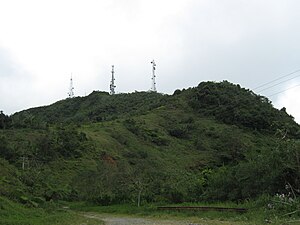
The following table lists the 50 highest mountain peaks of Puerto Rico that are located in the Cordillera Central, including those of the Sierra de Cayey. Note that some unnamed peaks in the region are not included.
| Rank | Mountain Peak | Municipality and (Barrio) | Location Reference | Elevation | Elevation Reference |
|---|---|---|---|---|---|
| 1 | Cerro de Punta | Ponce (Anón) | 4,357 ft (1,328 m) | ||
| 2 | Monte Jayuya | Jayuya (Saliente), Ponce (Anón) | 4,252 ft (1,296 m) | ||
| 3 | Cerro Rosa | Ciales (Toro Negro), Jayuya (Saliente) | 4,144 ft (1,263 m) | ||
| 4 | Piedra Blanca | Jayuya (Veguitas) | 4,042 ft (1,232 m) | ||
| 5 | Cerro Maravilla | Ponce (Anón) | 3,960 ft (1,207 m) | ||
| 6 | Monte Guilarte | Adjuntas (Guilarte) | 3,934 ft (1,199 m) | ||
| 7 | Los Tres Picachos | Ciales (Toro Negro), Jayuya (Coabey) | 3,894 ft (1,187 m) | ||
| 8 | Cerro Saliente | Jayuya (Saliente) | 3,845 ft (1,172 m) | ||
| 9 | Monte Membrillo | Yauco (Río Prieto) | 3,579 ft (1,091 m) | ||
| 10 | Cerro El Bolo | Orocovis (Ala de la Piedra), Villalba (Villalba Arriba) | 3,527 ft (1,075 m) | ||
| 11 | Cerro Doña Juana | Orocovis (Ala de la Piedra) | 3,471 ft (1,058 m) | ||
| 12 | Cerro Vaquiña | Adjuntas (Guilarte) | 3,369 ft (1,027 m) | ||
| 13 | Cerro Garrote | Peñuelas (Rucio) | 3,356 ft (1,023 m) | ||
| 14 | Cerrote de Peñuelas | Peñuelas (Rucio) | 3,307 ft (1,008 m) | ||
| 15 | Cerro El Gigante | Adjuntas (Saltillo) | 3,175 ft (968 m) | ||
| 16 | Cerro Morales | Jayuya (Jayuya Abajo), Utuado (Tetuán) | 3,126 ft (953 m) | ||
| 17 | Las Tres Palmas | Jayuya (Coabey) | 3,106 ft (947 m) | ||
| 18 | La Torrecilla | Barranquitas (Barrancas) | 3,057 ft (932 m) | ||
| 19 | Cerro Roncador | Utuado (Guaonico) | 3,038 ft (926 m) | ||
| 20 | Peña La Francia | Orocovis (Bauta Abajo) | 3,028 ft (923 m) | ||
| 21 | Cerro Prieto | Utuado (Viví Arriba) | 3,021 ft (921 m) | ||
| 22 | Cerro El Malo | Orocovis (Bermejales) | 3,005 ft (916 m) | ||
| 23 | Cerro Taita | Orocovis (Bauta Abajo) | 2,985 ft (910 m) | ||
| 24 | Cerro Novillo | Adjuntas (Portillo) | 2,952 ft (900 m) | ||
| 25 | Cerro La Santa | Caguas (San Salvador), Cayey (Farallón), San Lorenzo (Espino) | 2,903 ft (885 m) | ||
| 26 | Cerro Palo de Café | Jayuya (Mameyes Arriba) | 2,896 ft (883 m) | ||
| 27 | Cerro El Peligro | Guayanilla (Jagua Pasto, Quebrada Honda), Peñuelas (Macaná) | 2,890 ft (880 m) | ||
| 28 | Cerro Lloroso | Adjuntas (Tanamá, Yayales) | 2,883 ft (879 m) | ||
| 29 | Pico Rodadero | Yauco (Aguas Blancas, Duey, Sierra Alta) | 2,864 ft (873 m) | ||
| 30 | Cerro Pío | Orocovis (Damián Arriba, Saltos) | 2,841 ft (866 m) | ||
| 31 | Cerro Lucero | Caguas (San Salvador), Cayey (Farallón) | 2,831 ft (863 m) | ||
| 32 | Monte Hormiga | Adjuntas (Capáez) | 2,831 ft (863 m) | ||
| 33 | Cerro Medina | Adjuntas (Tanamá, Yayales) | 2,824 ft (861 m) | ||
| 34 | Cerro de La Tabla | Cayey (Jájome Alto), Guayama (Carite, Guamaní) | 2,808 ft (856 m) | ||
| 35 | Cerro Honoré | Patillas (Muñoz Rivera), San Lorenzo (Espino) | 2,795 ft (852 m) | ||
| 36 | Cerro Avispa | Cayey (Cercadillo) | 2,778 ft (847 m) | ||
| 37 | Cerro Magoyo | Jayuya (Mameyes Arriba) | 2,762 ft (842 m) | ||
| 38 | Cerro Las Tetas | Salinas (Lapa) | 2,759 ft (841 m) | ||
| 39 | Cerro La Chorrera | Adjuntas (Capáez), Utuado (Guaonico) | 2,739 ft (835 m) | ||
| 40 | Cerro Pulguillas | Coamo (Pulguillas) | 2,739 ft (835 m) | ||
| 41 | Cerro Curet | Yauco (Aguas Blancas) | 2,690 ft (820 m) | ||
| 42 | Cerro Mata de Plátano | Peñuelas (Jaguas) | 2,673 ft (815 m) | ||
| 43 | Monte El Gato | Cayey (Sumido) | 2,673 ft (815 m) | ||
| 44 | Cerro Garzas | Adjuntas (Garzas) | 2,641 ft (805 m) | ||
| 45 | Peña Domingo | Cayey (Pasto Viejo, Piedras) | 2,637 ft (804 m) | ||
| 46 | Cerro Don Quiño | Adjuntas (Yahuecas, Yayales) | 2,621 ft (799 m) | ||
| 47 | Cerro El Pico | Coamo (Pulguillas) | 2,598 ft (792 m) | ||
| 48 | Peñon de los Soldados | Cayey (Cercadillo), Salinas (Palmas) | 2,552 ft (778 m) | ||
| 49 | Cerro Mercado | Adjuntas (Portillo, Yahuecas) | 2,532 ft (772 m) | ||
| 50 | Cerro Farallón | Barranquitas (Quebradillas) | 2,552 ft (778 m) |
Gallery
- Cordillera Central and tabonuco forest in Sabana Grande.
- View of the Cordillera from the north in Piletas, Lares.
- Yauco Lake reservoir.
- Cordillera Central from Guayanilla Bay.
- Cerro de Punta, Puerto Rico's highest peak, from downtown Ponce.
- Cerro Las Tetas in Salinas close to the Aibonito Pass.
- Sierra de Cayey from Patillas Lake.
- View of Sierra de Guardarraya, the easternmost end of the Cordillera Central physiographic province, from Punta Tuna, Maunabo.
See also
References
- Proyecto Salón Hogar
- Cordillera Central / Central Mountain Range of Puerto Rico
- Nature Photos of El Yunque Rain Forest in Puerto Rico
- Welcome to Puerto Rico (Geography)
This article uses material from the Wikipedia English article Cordillera Central (Puerto Rico), which is released under the Creative Commons Attribution-ShareAlike 3.0 license ("CC BY-SA 3.0"); additional terms may apply (view authors). Content is available under CC BY-SA 4.0 unless otherwise noted. Images, videos and audio are available under their respective licenses.
®Wikipedia is a registered trademark of the Wiki Foundation, Inc. Wiki English (DUHOCTRUNGQUOC.VN) is an independent company and has no affiliation with Wiki Foundation.
